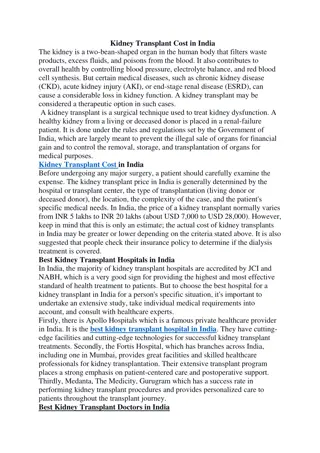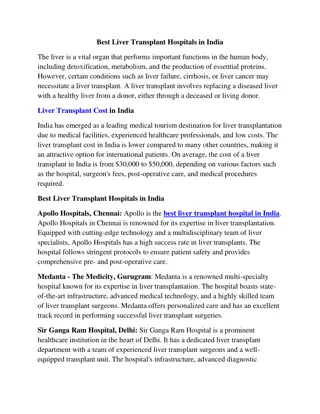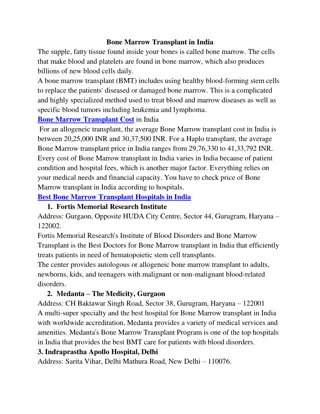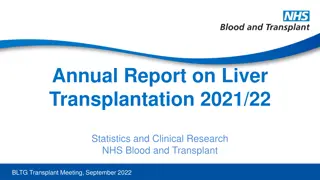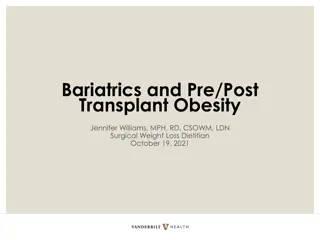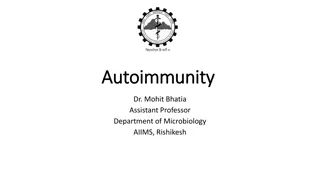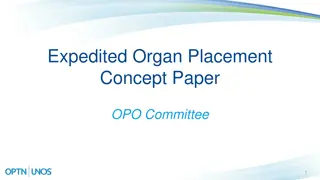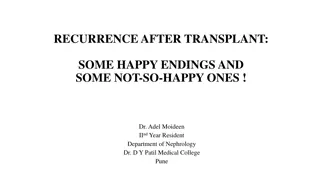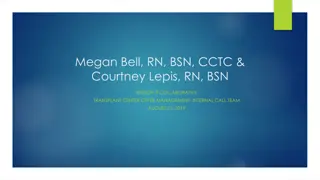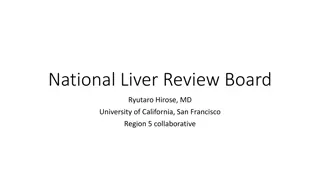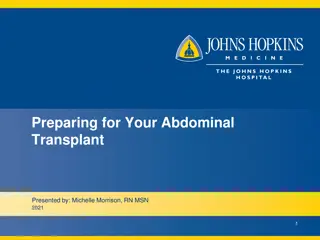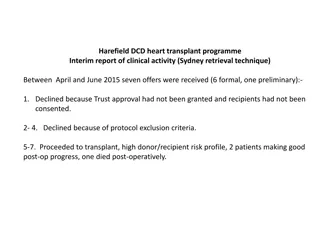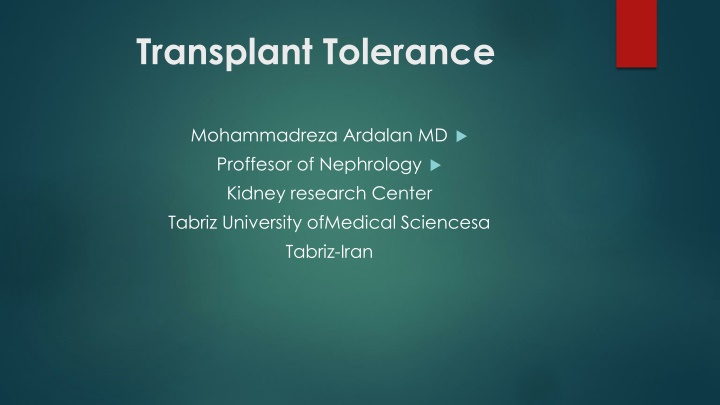
Progress in Achieving Transplant Tolerance: Insights from Kidney Transplant Research
Discover the latest advancements in transplant tolerance from studies on kidney transplant recipients. Explore the challenges and potential strategies for inducing operational tolerance in organ transplant recipients. Gain insights into the role of immune suppression drug withdrawal, chimerism induction, and maintenance immunotherapy withdrawal in achieving long-term tolerance. Learn about gene expression profiling and biomarkers for identifying tolerant patients undergoing immunosuppressive minimization.
Download Presentation

Please find below an Image/Link to download the presentation.
The content on the website is provided AS IS for your information and personal use only. It may not be sold, licensed, or shared on other websites without obtaining consent from the author. If you encounter any issues during the download, it is possible that the publisher has removed the file from their server.
You are allowed to download the files provided on this website for personal or commercial use, subject to the condition that they are used lawfully. All files are the property of their respective owners.
The content on the website is provided AS IS for your information and personal use only. It may not be sold, licensed, or shared on other websites without obtaining consent from the author.
E N D
Presentation Transcript
Transplant Tolerance Mohammadreza Ardalan MD Proffesor of Nephrology Kidney research Center Tabriz University ofMedical Sciencesa Tabriz-Iran
Scopes Continuous immunosuppression (IS) is necessary for preventing renal transplant (RT) rejection even between HLA-identical siblings. A few centers are conducting RT tolerance protocols in (HLA-id) and disparate living donor/recipient pairs. HLA-identical whether the tolerance induced will be permanent /lifetime, whether such kidneys remain immunologically undisturbed. Only time will tell. Leventhal, J.R., Human Immunology (2018),
considerable progress has been made in achieving immune suppression drug withdrawal after cell therapy in recipients of organ transplants Tolerance strategies are based on induction immunotherapy, transfer of donor cells to induce chimerism, and subsequent withdrawal of maintenance immunotherapy Clinical trials utilizing these approaches demonstrate that tolerance induction does not work in all patients. Kawai T,Summary of the Third International Workshop on Clinical Tolerance.2018 AJT
Spontaneous Operational Tolerance immunosuppressed allograft recipients who stop therapy generally experience rejection and premature graft failure. However, the occasional patient who conducts this experiment having experienced operational tolerance by happenstance.
Studies of kidney transplant recipients who have experienced operational tolerance have focused on B and T cell repertoires and gene expression profiles Newell et al. report that tolerant individuals express increased numbers of developmentally and functionally different B cells and its gene expression in blood and urine. Newell KA ,Hum Immunol 79.2018
Asare et al. conducted a prospective multicenter study to identify patients who may be tolerant within a cohort of candidates for immunosuppressive minimization by gene expression of B cell receptors, Ig-k variable 1D-13 (IGKV1D-13) and IGKV4-1 tolerance "signature" Asare A, Am J Transplant 17, 2017
Contrary to expectations, the frequency of predicted tolerance was greater in patients receiving tacrolimus and reduced in individuals receiving corticosteroids or mycophenolate mofetil, or in those who received rabbit antithymocyte globulin (rATG) as induction therapy. Asare A, Am J Transplant 17, 2017
Chenouard et al. studied T follicular helper (Tfh) cells, which play a critical role in B cell differentiation and may associate with tolerance. Distinct changes in Tfh subsets and modified gene expression profiles in tolerant recipients were observed. Chenouard A, Am J Transplant 17, 2017
Danger et al. developed a 20-gene signature from a microarray analysis performed on 46 operationally tolerant patients and 266 renal transplant recipients with stable function . They identified a robust combination of 6 genes and 2 demographic parameters associated with operational tolerance, remains to be determined. but its reproducibility Danger R, Am J Transplant 19, 2019
Tolerance Induction Protocol Principles The donor is pretreated with granulocyte colony-stimulating stem cells to migrate from the bone marrow into the peripheral blood, which are subsequently procured using apheresis, and enriched for CD34+ cells The donor cells are infused into the transplant recipient after total lymphoid or body irradiation The donor s immune cells create a chimeric immune system within the recipient If the donor and recipient are HLA-matched siblings, the recipient has a chance of 80% chance for the development of tolerance and may be weaned from immunosuppression
Tolerance induction Kawai International Workshop on Clinical Tolerance held in Stanford, California, in 2017 and four medical centers presented updates of their tolerance induction regimens and outcomes of recipients. and its prescence for at least 6 months is needed before immune suppression cessation. and colleagues provided a summary of the Third Chimerism induction persistence of chimerism is necessary to achieve tolerance in HLA mismatched kidney transplant recipients Summary of the Third International Workshop on Clinical Tolerance.2018 AJT
S. Strober chimerism is necessary in, a critical period in HLA identical recipients allows for the development of stable operational tolerance. Most of these subjects lost this mixed chimerism following the withdrawal of immunosuppression, yet operational tolerance persisted. In contrast mismatched and immunosuppression dependent mixed chimerism for at least 1 year did not become tolerant after loss of chimerism. describes that phenomenon of multilineage mixed haploidentical subjects with Kawai T,Summary of the Third International Workshop on Clinical Tolerance.2018 AJT
Tolerance to HLA-matched and -mismatched living donor kidney transplants was achieved in more than 50 patient enrolled in trials in four medical centers after establishment of transient or persistent chimerism. Kawai T,Summary of the Third International Workshop on Clinical Tolerance.2018 AJT
Leventhal et al. experience with HLA-identical living-donor kidney transplant recipients given donor hematopoietic stem cells. This cohort has been followed up for as long as 9 years. persistently elevated T-regulatory cells CD4+/CD25(High)/ CD127 /FOXP3+ are found in peripheral blood of tolerant individuals. Leventhal JR.Hum Immunol 79:2019
Biomarkers renal tubular damage by measuring a variety of markers that included kidney injury molecule-1 (KIM-1), urine a1-microglobulin (A1M), amino- terminal propeptide of type III procollagen (PIIINP), and neutrophil gelatinase-associated lipocalin (NGAL) may help for monitoring the allograft. Ann Intern Med 169: 610 618, 2018
Biomarkers Befor Transplant New HLA molecular typing techniques enabled more accurate determination of the three-dimensional building blocks that form the antibody binding sites of each HLA allele. Such immunogenic HLA regions are known as eplet epitopes. Compared with traditional HLA-DR/DQ whole-antigen mismatch, HLA-DR/ DQsingle-molecule eplet correlation with de novo DSA development. mismatch improved the A prognostic biomarker for primary alloimmunity. Am J Transplant 19: 1708 1719, 2019
Biomarkers Befor Transplant Subclinical acute rejection (subAR) is currently detectable only with surveillance biopsies, is often detected late, and contributes to premature allograft failure. molecular/genetic biomarker profile for subAR blood is necessary. develop a blood-based using peripheral Am J Transplant 19: 98 109, 2019
Biomarkers Before Transplant Aside from anti-HLA antibodies, are there other assays that predict increased rejection risk before transplantation? Emerging evidence indicates that the monocyte/macrophage lineage participates in the pathogenesis of rejection higher pre transplant numbers of pro inflammatory CD16+ monocytes may predict rejection Am J Transplant 17: 2659 2667, 2017
Biomarkers after Transplant Knight et al. systematically reviewed donor-derived, cell-free DNA (dd-cfDNA) in urine or blood of transplant recipients as another promising AR biomarker. In general, dd-cfDNA falls rapidly within 2 weeks. Levels are elevated in the presence of allograft injury, including AR and infection, and return to baseline after successful treatment. Elevated cfDNA levels are documentable in advance of clinically apparent rejection Knight SR, Transplantation 2019
An alternative approach to measuring urinary protein biomarkers is to examine urinary RNA. An advantage of microRNAs compared with mRNAs is greater stability in urine. van de Vrie M Am J Transplant 2017



